The service delivery mechanism of federal, state and local governments in Nepal should be mobilized to minimize the consequences of the Covid-19 pandemic so as to save both the lives and livelihoods of the Nepalese people, argues Rajesh Paudel in this blog.
CONTEXT
Farmers are the group most vulnerable to the Covid-19 pandemic. Majority of the poor people in Nepal rely on agriculture and its associated businesses for their livelihoods. Lockdowns – as an effective method of protection from the corona virus – had direct impact on migrant workers and the agriculture supply chain but the cost was severe as migrants lost wages and the basic spending of vulnerable groups dropped (Scott et al. 2020). Maintaining a steady food system (in the USA) has become a challenge at the time of the Covid-19 (L. Laborde & Bucknavage 2020). The existing rural system of Nepal is being affected as the global economy is being influenced by various factors arising due to the corona pandemic. In Nepal a significant portion of the economically active population is in foreign employment. The major regions that supply those human resources are from rural and suburban areas of Nepal. As the global economy is in crisis, it’s certain that the rural system of Nepal will be influenced significantly. This blog is based on an appraisal of review papers, reports, online newspapers, journals and research articles, supplemented with my understanding and knowledge on the topic and the specific country context.
IMPACT ON FARMERS
With the spread of COVID-19, farmers in Nepal are now exposed to new major challenges. The most alarming challenge is its immediate impact on farming activities that is bringing about a new economic and political order in its wake. The next major challenge is its negative impact on the livelihood of farmers given the unique features of the Nepalese agrarian or rural system (Figure 1).
Lockdown of rural and urban areas as a first preventive measure against COVID-19 contributes to a drop in the demand for daily consumption of agricultural and livestock produce. In countries such as Nepal, food demand depends on people’s earnings and so fewer earning opportunities impact consumption (FAO 2020). Consequently, if the lockdown continues for a lengthier period there will be less production in the coming season. The Asian Development Bank (ADB) has already stated that the economy of Nepal will go down after the COVID-19 crisis and is expected to decelerate economic growth to 5.3 percent in 2020 (Asian Development Bank 2020). Farmers are the economically most affected community under the COVID-19 crisis. The financial crisis in Nepal could delay/stop financial assistance for farmers from the government.
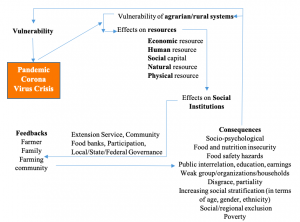 Figure 1: A proposed model showing the impact of COVID-19 on the Nepalese agrarian/rural system
Figure 1: A proposed model showing the impact of COVID-19 on the Nepalese agrarian/rural system
SOLUTIONS
FAO (2020) recommendation for mitigating risk of COVID-19 on food security and nutrition are; meeting the urgent food needs of vulnerable population, boosting social protection programs and reducing the trade related costs. Economic and social assistance measures like fiscal stimulus and social safety would obstruct poverty and famine in developing countries (D. Laborde et al. 2020). In Nepal, these mitigation measures would have positive results in decreasing vulnerability and developing local food systems. Furthermore, the three levels of government (federal, state and local) may include additional packages so as to address food and nutrition security, implement cash transfer, and help migrant workers – as done in India (Dev 2020).
Strengthening agricultural production
In Nepal, a vast majority of the rural and suburban population is involved in agricultural activities for their income. Nepal’s largest economic activity is agriculture; and its contribution to the GDP was 26.98 percent in 2019 (Ministry of Finance 2019). So it is urgent to organize proper planning in agriculture service delivery through local, state and federal governments. To address the impact of COVID-19 on food systems line agencies in agriculture, food safety and health have to work together. Quick adaptation strategies to new conditions and intensive care from the community are critical. Good agricultural practices (GAP) and good handling practices would be helpful in preventing the possible transmission of Covid-19. (GC 2020). Social protection programmes that include the most helpless farming communities should be the priority (Swinnen 2020).
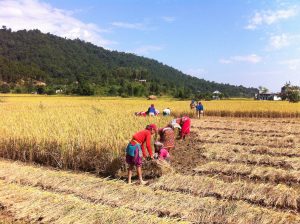
Image Credit- Niru Das YPARD
Protection should be given to all those engaged in agricultural production, which includes farmers, farm workers, agricultural experts and all those engaged in farm mechanization (tools, equipment and machineries), and farm input/output marketing. Extension and Advisory Services should support communities to adapt to the new situation. In this crisis it is most important to shorten the production and supply chain and bring it closer to the consumer. Farmers are facing problems with marketing their produce, especially perishables (milk, fruits and vegetables).
OPPORTUNITIES
The coronavirus crisis has highlighted the drawbacks of globalization and it is likely to impact free flow of people and goods. In this situation, protectionism may prevail. Agricultural protectionism is a scheme of government measures to protect local agricultural and livestock production from international competition by depressing or hindering imports from the foreign country (Markovic & Markovic, 2014). The developed country-centered global supply chains on which so many companies in poor and rich countries have come to depend are principally under threat. The current supply chain (local, state, regional and global) will be disturbed and changed. International trade of agricultural and livestock products is likely to get limited. As a result the local food system of Nepal could discover emerging opportunities to develop itself. Nepalese farmers should be ready to change themselves according to changing conditions because factors of production (land, labor and capital) are being altered due to this pandemic. Some positive effects could evolve from the COVID-19 crisis if farmers can diversify agricultural and livestock production for meeting local necessities.
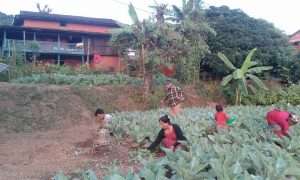 Image Credit- Sagar GC YPARD
Image Credit- Sagar GC YPARD
FINAL WORDS
The COVID-19 crisis is not only a public health issue but also a major food systems issue. This crisis has clearly exposed once again the vulnerability of Nepalese farmers, family and farming communities to international economic shocks. To enhance the resilience of Nepalese farmers, a more inclusive food system has to emerge with the support of local, state and federal governments.
Extension and Advisory Services (EAS) can play a major role in supporting farmers in dealing with this crisis. These include:
- Initiating a nation-wide survey for understanding people’s food security situation – focusing on food production and access to food, and then develop a complete data set based on these;
- Developing plans for enhancing recovery and strengthening future preparedness to crises like these by developing inclusive local food systems.
References
Asian Development Bank. 2020. Macroeconomic update: Nepal (April 2020). https://www.adb.org/sites/default/files/institutional-document/577946/nepal-macroeconomic-update-202004.pdf
Dev SM. 2020. Addressing COVID-19 impacts on agriculture, food security, and livelihoods in India. https://www.ifpri.org/blog/addressing-covid-19-impacts-agriculture-food-security-and-livelihoods-india
FAO. 2020. COVID-19 pandemic – impact on food and agriculture. http://www.fao.org/2019-ncov/q-and-a/impact-on-food-and-agriculture/en/
GC A. 2020. Food during the coronavirus crisis. https://kathmandupost.com/columns/2020/04/08/food-during-the-coronavirus-crisis
Laborde D, Martin W and Vos R. 2020. Poverty and food insecurity could grow dramatically as COVID-19 spreads. https://www.ifpri.org/blog/poverty-and-food-insecurity-could-grow-dramatically-covid-19-spreads
Laborde L and Bucknavage M. 2020. Continuity of food system critical during COVID-19 pandemic. https://extension.psu.edu/continuity-of-food-system-critical-during-covid-19-pandemic
Markovic I and Markovic M. 2020. Agricultural protectionism of the European union in the conditions of international trade liberalization. Ekonomika Poljoprivrede, 61(2), 423–440. https://doi.org/10.5937/ekopolj1402423mMinistry of Finance, Government of Nepal. 2019. Economic Survey 2018/19. https://mof.gov.np/uploads/document/file/compiled economic Survey english 7-25_20191111101758.pdf
Scott R, Heather R, Huan W and Dill E. 2020. Lockdowns are protecting China’s rural families from COVID-19, but the economic burden is heavy. https://www.ifpri.org/blog/lockdowns-are-protecting-chinas-rural-families-covid-19-economic-burden-heavy
Swinnen J. 2020. Global Food Policy Report 2020: Inclusive food systems can help sustainable development and resilience to shocks. International Food Policy Research Institute. https://www.ifpri.org/blog/global-food-policy-report-2020-inclusive-food-systems-can-help-sustainable-development-and
 Rajesh Paudel is Assistant Professor & Director, Directorate of Extension, Institute of Agriculture and Animal Science, Tribhuvan University, Kirtipur, Kathmandu, Nepal.
Rajesh Paudel is Assistant Professor & Director, Directorate of Extension, Institute of Agriculture and Animal Science, Tribhuvan University, Kirtipur, Kathmandu, Nepal.
(Email: raj5yes@gmail.com, rajesh@iaas.edu.np)

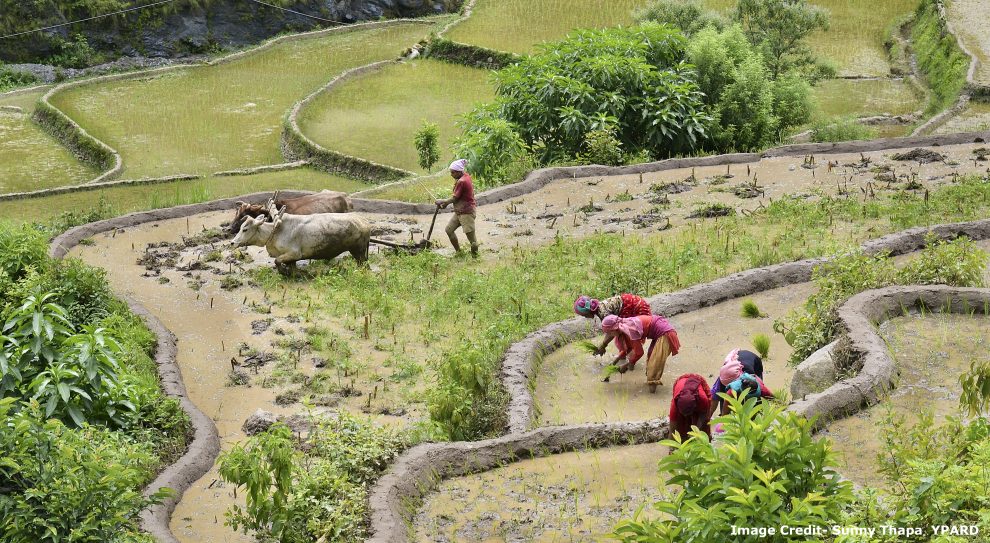

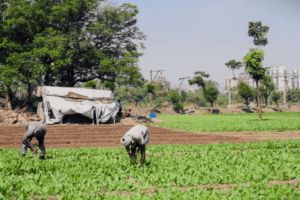

Add Comment